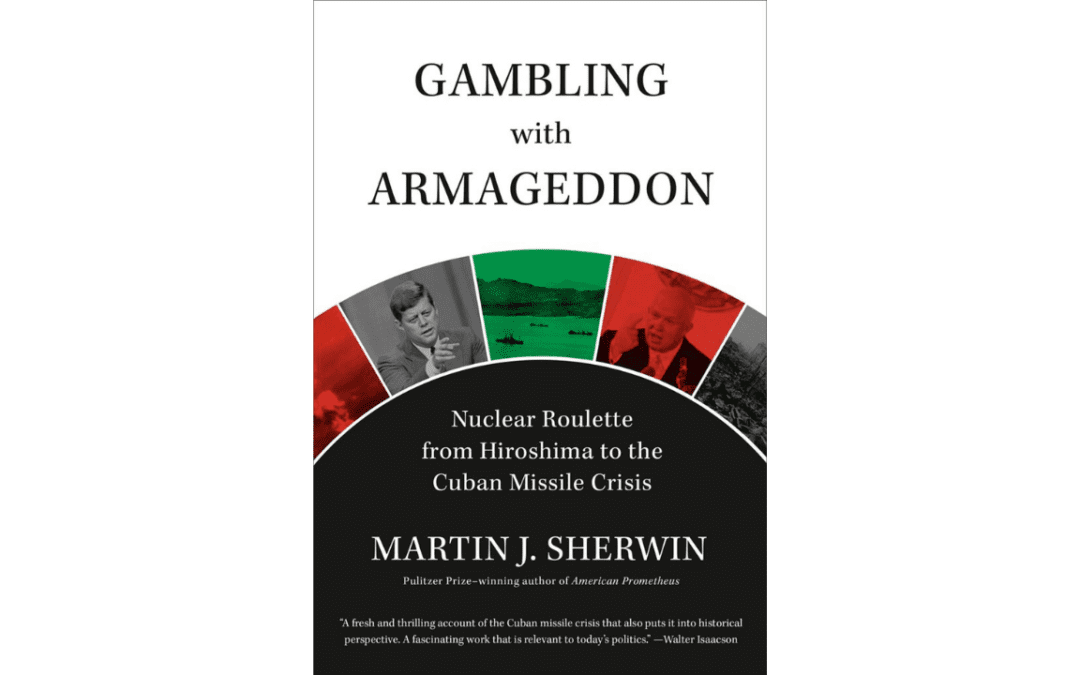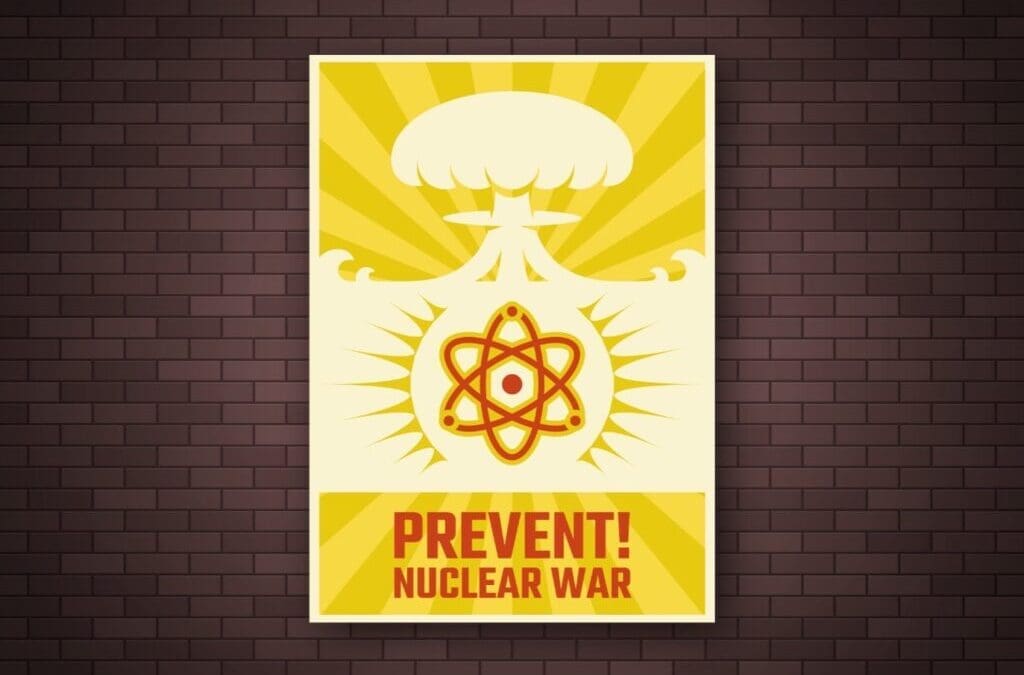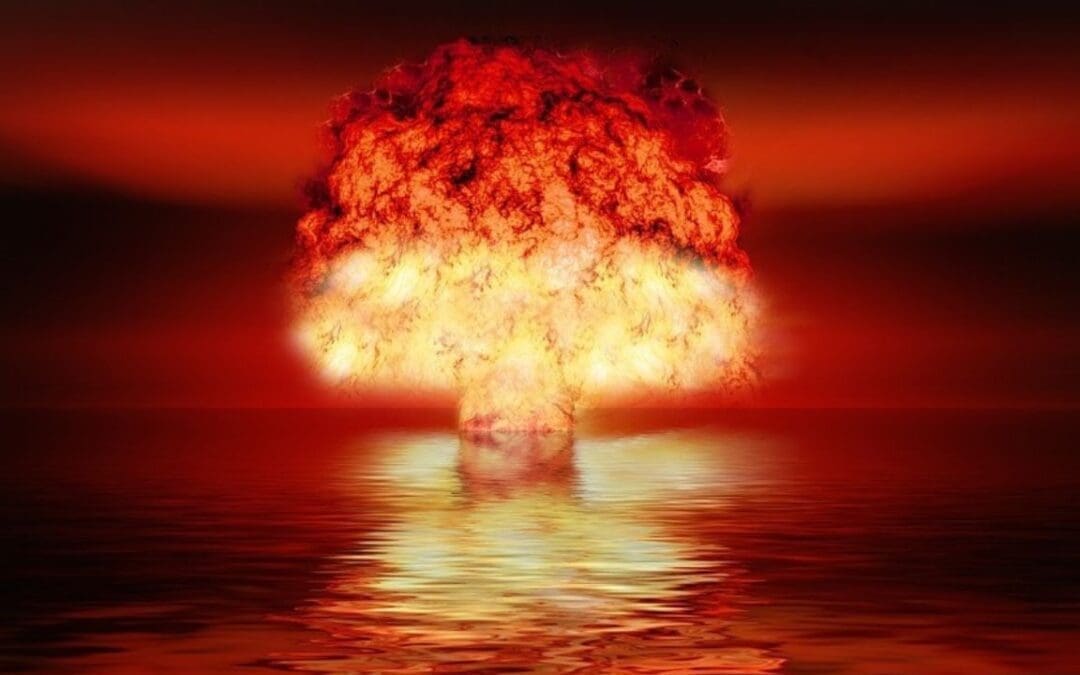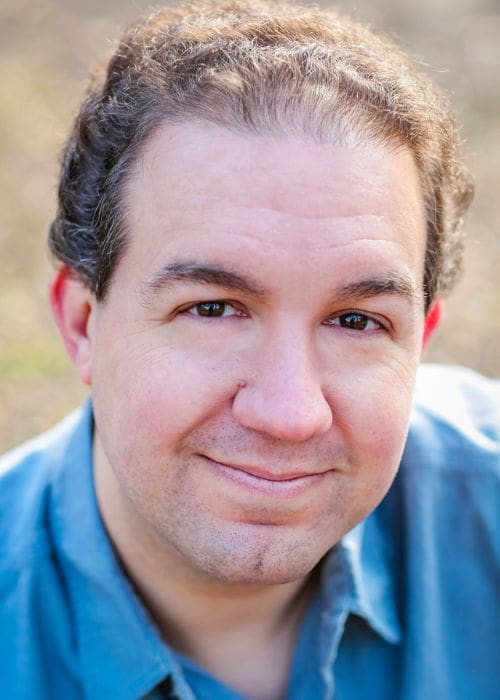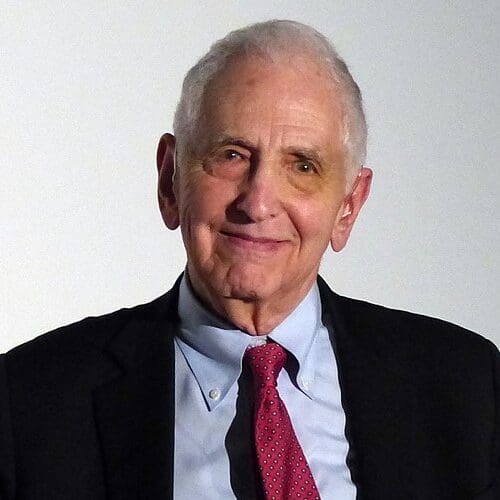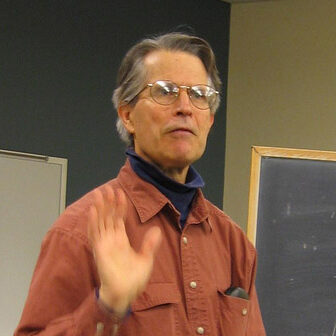
by Lawrence Wittner | Jan 18, 2023 | Disarmament
The development and the deployment of nuclear weapons are usually based on the assumption that they enhance national security. But, in fact, as this powerful study of nuclear policy convincingly demonstrates, nuclear weapons move nations toward the brink of destruction.
The basis for this conclusion is the post-World War II nuclear arms race and, especially, the Cuban missile crisis of October 1962. At the height of the crisis, top officials from the governments of the United States and the Soviet Union narrowly avoided annihilating a substantial portion of the human race by what former U.S. Secretary of State Dean Acheson, an important participant in the events, called “plain dumb luck.”
The author of this cautionary account, Martin Sherwin, who died shortly after its publication, was certainly well-qualified to tell this chilling story. A professor of history at George Mason University, Sherwin was the author of the influential A World Destroyed: Hiroshima and Its Legacies and the co-author, with Kai Bird, of American Prometheus: The Triumph and Tragedy of J. Robert Oppenheimer, which, in 2006, won the Pulitzer Prize for biography. Perhaps the key factor in generating these three scholarly works was Sherwin’s service as a U.S. Navy junior intelligence officer who was ordered to present top secret war plans to his commander during the Cuban missile crisis.
The Rise of Nuclear Weapons in International Affairs
In Gambling with Armageddon, Sherwin shows deftly how nuclear weapons gradually became a key part of international relations. Although Harry Truman favored some limitations on the integration of these weapons into U.S. national security strategy, his successor, Dwight Eisenhower, significantly expanded their role. According to the Eisenhower administration’s NSC 162/2, the U.S. government would henceforth “consider nuclear weapons as available for use as other munitions.” At Eisenhower’s direction, Sherwin notes, “nuclear weapons were no longer an element of American military power; they were its primary instrument.”
Sherwin adds that, although the major purpose of the new U.S. “massive retaliation” strategy “was to frighten Soviet leaders and stymie their ambitions,” its “principal result . . . was to establish a blueprint for Nikita Khrushchev to create his own ‘nuclear brinkmanship.’” John F. Kennedy’s early approach to U.S. national security policy―supplementing U.S. nuclear superiority with additional conventional military forces and sponsoring a CIA-directed invasion of Cuba―merely bolstered Khrushchev’s determination to contest U.S. power in world affairs. Consequently, resumption of Soviet nuclear weapons testing and a Soviet-American crisis over Berlin followed.
A Crisis Emerges Over Cuba
Indeed, dismayed by U.S. nuclear superiority and feeling disrespected by the U.S. government, Khrushchev decided to secretly deploy medium- and intermediate-range ballistic nuclear missiles in Cuba. As Sherwin observes, the Soviet leader sought thereby “to protect Cuba, to even the balance of nuclear weapons and nuclear fear, and to reinforce his leverage to resolve the West Berlin problem.” Assuming that the missiles would not be noticed until their deployment was completed, Khrushchev thought that the Kennedy administration, faced with a fait accompli, would have no choice but to accept them. Khrushchev was certainly not expecting a nuclear war.
But that is what nearly occurred. In the aftermath of the U.S. government’s discovery of the missile deployment in Cuba, the Joint Chiefs of Staff demanded the bombing and invasion of the island and were supported by most members of ExComm, an ad hoc group of Kennedy’s top advisors during the crisis. At the time, they did not realize that the Soviet government had already succeeded in delivering 164 nuclear warheads to Cuba and, therefore, that a substantial number of the ballistic missiles on the island were already operational. Also, the 42,000 Soviet troops in Cuba were armed with tactical nuclear weapons and had been given authorization to use them to repel an invasion. As Fidel Castro later remarked: “It goes without saying that in the event of an invasion, we would have had nuclear war.”
Initially, among all of Kennedy’s advisors, only Adlai Stevenson, the U.S. ambassador to the United Nations, suggested employing a political means―rather than a military one―to secure the removal of the missiles. Although Kennedy personally disliked Stevenson, he recognized the wisdom of his UN ambassador’s approach and gradually began to adopt his ideas. “The question really is,” the president told his hawkish advisors, “what action we take which lessens the chance of a nuclear exchange, which obviously is the final failure.” Therefore, Kennedy tempered his initial impulse to order rapid military action and, instead, adopted a plan for a naval blockade (“quarantine”) of Cuba, thereby halting the arrival of additional Soviet missiles and creating time for negotiations with Khrushchev for removal of the missiles already deployed.
U.S. military leaders, among other ostensible “wise men,” were appalled by what they considered the weakness of the blockade plan, though partially appeased by Kennedy’s assurances that, if it failed to secure the desired results within a seven-day period, a massive U.S. military attack on the island would follow. Indeed, as Sherwin reveals, at the beginning of October, before the discovery of the missiles, the U.S. Joint Chiefs of Staff were already planning for an invasion of Cuba and looking for an excuse to justify it.
Sliding Toward Disaster
Even though Khrushchev, like Kennedy, regarded the blockade as a useful opportunity to negotiate key issues, they quickly lost control of the volatile situation.
For example, U.S. military officers took the U.S.-Soviet confrontation to new heights. Acting on his own initiative, General Thomas Power, the head of the U.S. Strategic Air Command, advanced its nuclear forces to DEFCON 2, just one step short of nuclear war―the only occasion when that level of nuclear alert was ever instituted. He also broadcast the U.S. alert level “in the clear,” ensuring that the Russians would intercept it. They did, and promptly raised their nuclear alert level to the same status.
In addition, few participants in the crisis seemed to know exactly what should be done if a Soviet ship did not respect the U.S. blockade of Cuba. Should the U.S. Navy demand to board it? Fire upon it? Furthermore, at Castro’s orders, a Soviet surface-to-air battery in Cuba shot down an American U-2 surveillance flight, killing the pilot. Khrushchev was apoplectic at the provocative action, while the Kennedy administration faced the quandary of how to respond to it.
A particularly dangerous incident occurred in the Sargasso Sea, near Cuba. To bolster the Soviet defense of Cuba, four Soviet submarines, each armed with a torpedo housing a 15-kiloton nuclear warhead, had been dispatched to the island. After a long, harrowing trip through unusually stormy seas, these vessels were badly battered when they arrived off Cuba. Cut off from communication with Moscow, their crews had no idea whether the United States and the Soviet Union were already at war.
All they did know was that a fleet of U.S. naval warships and warplanes was apparently attacking one of the stricken Soviet submarines, using the unorthodox (and unauthorized) tactic of forcing it to surface by flinging hand grenades into its vicinity. One of the Soviet crew members recalled that “it felt like you were sitting in a metal barrel while somebody is constantly blasting with a sledgehammer.” Given the depletion of the submarine’s batteries and the tropical waters, temperatures ranged in the submarine between 113 and 149 degrees Fahrenheit. The air was foul, fresh water was in short supply, and crew members were reportedly “dropping like dominoes.” Unhinged by the insufferable conditions below deck and convinced that his submarine was under attack, the vessel’s captain ordered his weapons officer to assemble the nuclear torpedo for action. “We’re gonna blast them now!” he screamed. We will die, but we will sink them all―we will not become the shame of the fleet.”
At this point, though, Captain Vasily Arkhipov, a young Soviet brigade chief of staff who had been randomly assigned to the submarine, intervened. Calming the distraught captain, he eventually convinced him that the apparent military attack, plus subsequent machine gun fire from U.S. Navy aircraft, probably constituted no more than a demand to surface. And so they did. Arkhipov’s action, Sherwin notes, saved not only the lives of the submarine crew, “but also the lives of thousands of U.S. sailors and millions of innocent civilians who would have been killed in the nuclear exchanges that certainly would have followed from the destruction” that the “nuclear torpedo would have wreaked upon those U.S. Navy vessels.”
Although the Crisis is Resolved Peacefully, the Lesson is Lost
Meanwhile, recognizing that the situation was fast slipping out of their hands, Kennedy and Khrushchev did some tense but serious bargaining. Ultimately, they agreed that Khrushchev would remove the missiles, while Kennedy would issue a public pledge not to invade Cuba. Moreover, Kennedy would remove U.S. nuclear missiles from Turkey―reciprocal action that made sense to both men, although, for political reasons, Kennedy insisted on keeping the missile swap a secret. Thus, the missile crisis ended with a diplomatic solution.
Ironically, continued secrecy about the Cuba-Turkey missile swap, combined with illusions of smooth Kennedy administration calibrations of power spun by ExComm participants and the mass communications media, led to a long-term, comforting, and triumphalist picture of the missile crisis. Consequently, most Americans ended up with the impression that Kennedy stood firm in his demands, while Khrushchev “blinked.” It was a hawkish “lesson”―and a false one. As Sherwin points out, “the real lesson of the Cuban missile crisis . . . is that nuclear armaments create the perils they are deployed to prevent, but are of little use in resolving them.”
Although numerous books have been written about the Cuban missile crisis, Gambling with Armageddon ranks as the best of them. Factually detailed, clearly and dramatically written, and grounded in massive research, it is a work of enormous power and erudition. As such, it represents an outstanding achievement by one of the pre-eminent U.S. historians.
Like Sherwin’s other works, Gambling with Armageddon also grapples with one of the world’s major problems: the prospect of nuclear annihilation. At the least, it reveals that, while nuclear weapons exist, the world remains in peril. On a deeper level, it suggests the need to move beyond considerations of national security to international security, including the abolition of nuclear weapons and the peaceful resolution of conflict among nations.
Securing these goals might necessitate a long journey, but Sherwin’s writings remind us that, to safeguard human survival, there’s really no alternative to pressing forward with it.

by Lawrence Wittner | Jan 1, 2023 | Disarmament, World Federation
Russia’s war upon Ukraine should remind us that violent international conflicts not only persist, but constitute a plague upon the world.
Over thousands of years, wars have brought immense suffering to people around the globe. In addition to the widespread annihilation of human life, wars have produced vast material losses, including the destruction of homes, schools, hospitals, entire cities, the environment, and much of what people value as civilization. They have also channeled enormous financial resources into military buildups that, even if not employed in battle, deprive other public and private programs of adequate attention and funding. Also, since World War II, when nuclear weapons were first developed and used with terrible effect, the means of waging war have entered a new dimension, giving it the power to destroy virtually all life on earth.
Although, in recent centuries, many people have lamented war’s squandering of blood and treasure, as well as the suicidal nature of modern war, they have not yet found an effective way to stop it.
Public Efforts to Avoid War
One popular response to war is isolationism, which is designed to keep one’s nation out of the conflict. But this policy (labeled “America First” in the United States) ignores the suffering of other people and, of course, does nothing to stop a war elsewhere. In addition, it is often accompanied by a military buildup of one’s own nation, a policy that has a poor track record when it comes to preventing war.
Pacifism is on a higher ethical plane, for it deplores the horrors produced by militarism and war. Furthermore, if most people around the world accepted the absolute pacifist position (which rejects military force in all circumstances), pacifists might be able to prevent wars from occurring or continuing. But this is not the case and, given widespread public support for “just wars” (including defense against invasion), seems unlikely to become so. Nonviolent resistance, a form of radical pacifism, has greater potentiality as an alternative to war or surrender, although its full promise has yet to be realized in coping with international war.
Effective Governance and Violent Behavior
By contrast, within nations there are alternatives to violent behavior that, although not always totally effective, do reduce it substantially. Legislative bodies enact laws, while police and judicial institutions enforce these laws. Unfortunately, on the global level, these institutions are so rudimentary and limited in power that they fail to produce an effective check upon violence. Thus, on the national level, governments can restrain violence by individuals, mobs, or insurrectionists. But, on the international level, things proceed much as they did in the American Wild West of yesteryear. In this state of international anarchy, strong nations all too often threaten or wage war upon the weak, and nations often feel insecure unless they maintain a substantial capacity for war.
In short, while nations have established useful governance at the national level, the world lacks effective governance at the international level. As a result, when nations have an international conflict, they are tempted, in the absence of the force of law, to invoke the law of force.
Strengthening Global Governance
Even so, the nations of the world could unite in the interest of their common security and bolster institutions of global governance. To strengthen the UN Security Council, they could abolish the veto and substitute a rotating membership for the permanent membership of Russia, China, the United States, Britain, and France. To strengthen the General Assembly, they could give it additional legislative power, including the power to fund the United Nations through taxation. To enhance the democratic nature of the United Nations, they could establish a world parliament, with representatives elected by the public rather than selected by national governments. Additional power could also be granted to the International Criminal Court and to the International Court of Justice to conduct investigations, deliver judgments, and enforce their rulings.
These kinds of reform measures have been advocated for years by the World Federalist Movement/Institute for Global Policy and by its U.S. member organization, Citizens for Global Solutions. Strengthened governmental authority on the global level is also supported by world public opinion.
A stronger array of international institutions is not a cure-all for international war. But, like the enforcement of gun control within nations, it would significantly reduce the number of violent incidents. It would help prevent international aggression. And it would save the world from nuclear war by enforcing the UN Treaty on the Prohibition of Nuclear Weapons. After thousands of years of blood and plunder, topped off in recent decades by the looming danger of a nuclear holocaust, isn’t it time to give strengthened global governance a try?
Nations of the world unite! You have nothing to lose but your wars.

by Lawrence Wittner | Nov 28, 2022 | Disarmament, Peace
Even international alliances can unravel when nations confront the insanity of a nuclear holocaust.
An illustration of this point occurred recently, after Vladimir Putin once again threatened Ukraine and other nations with nuclear war. “To defend Russia and our people, we doubtlessly will use all weapons resources at our disposal,” the Russian president said. “This is not a bluff.” In response to this statement and to sharp UN condemnation of Russian nuclear threats, Chinese president Xi Jinping issued a public statement early this November, assailing “the use of, or threats to use nuclear weapons.” To “prevent a nuclear crisis” in Europe or Asia, he insisted, the world should “advocate that nuclear weapons cannot be used” and “a nuclear war cannot be waged.”
Aren’t these two nuclear-armed nations currently aligned in their resistance to U.S. foreign policy? Yes, they are, and when it came to Putin’s war upon Ukraine, Xi refrained from suggesting a Russian withdrawal. But nuclear war, as the Chinese leader made clear, was simply not acceptable.
This was not the first time a Russian-Chinese alliance was ruffled by a dispute over the use of nuclear weapons. An even deeper conflict occurred during the late 1950s and early 1960s when, ironically, the roles of the two nations were exactly the reverse.
At that time, the Chinese government, led by Mao Zedong, was embarked on a crash program to develop nuclear weapons. In October 1957, China’s weapons program secured a major gain when the Russian and Chinese governments signed the New Defense Technical Accord, in which the Russians agreed to supplementing the nuclear assistance they had already provided to the Chinese by supplying them with a prototype atomic bomb, missiles, and useful technical data.
But Russian officials soon had reason to doubt the wisdom of assisting China’s nuclear weapons development program. As Soviet premier Nikita Khrushchev recalled, the following month, at a Moscow conclave of Communist party leaders from around the world, Mao gave a speech on nuclear war that startled those in attendance. According to the Soviet leader, the “gist” of Mao’s speech was: “We shouldn’t fear war. We shouldn’t be afraid of atomic bombs and missiles. No matter what kind of war breaks out―conventional or thermonuclear―we’ll win.” When it came to China, Mao reportedly said, “we may lose more than three hundred million people. So what? War is war. The years will pass, and we’ll get to work producing more babies than ever before.”
Khrushchev found Mao’s remarks “deeply disturbing,” and recalled with irritation: “Everybody except Mao was thinking about how to avoid war. Our principal slogan was ‘On with the Struggle for Peace and Peaceful Coexistence.’ Yet here came Mao . . . saying we shouldn’t be afraid of war.’ In early 1958, as Soviet doubts increased about the reliability of China’s leadership in dealing with nuclear weapons, Khrushchev decided to postpone shipment of the prototype atomic bomb to China.
Eventually, the Soviet government not only withdrew its assistance to the Chinese nuclear weapons program in 1960, but took steps that placed the Soviet Union at loggerheads with the Chinese leadership. Key among these steps was working out an agreement on a nuclear test ban treaty with the governments of the United States and Britain—an agreement that, in part, was designed to block the ability of China to become a nuclear power. This Soviet shift toward a nuclear arms control and disarmament treaty with the West was bitterly opposed by China’s rulers, who were determined to develop nuclear weapons and, by 1964, succeeded in doing so. Meanwhile, the Sino-Soviet rift grew ever more heated, with the Chinese pulling out of the Soviet-dominated World Peace Council and ferociously competing with the Russians for leadership of the world Communist movement.
There are some lessons that can be learned from these incidents, in which major powers displayed signs of veering toward nuclear war. The obvious one is that even military allies might balk, at times, when they see an international confrontation slipping toward a nuclear disaster. Another, less evident, is that nations with access to nuclear weapons are not necessarily restrained from threatening or waging nuclear war by the prospect of nuclear retaliation from other nuclear powers. Or, to put it another way, nuclear deterrence is unreliable. Above all, these events and others underscore the fact that, while nuclear weapons exist, the world remains in peril.
Fortunately, abolishing nuclear weapons before they destroy the world is not an utterly utopian prospect. Thanks to popular pressure and disarmament treaties, the number of nuclear weapons around the globe has been reduced since 1986 from about 70,000 to 12,700. Moreover, a UN Treaty on the Prohibition of Nuclear Weapons, crafted and approved by an overwhelming majority of the world’s nations, went into effect in January 2021.
Unfortunately, none of the world’s nine nuclear powers has signed or ratified this nuclear weapons abolition treaty. Until they do so and, therefore, stop producing, stockpiling, and distributing nuclear weapons to other countries, the world will continue to live in a state of nuclear peril, subject only to occasional flashes of sanity by these same nuclear-armed nations.
Surely, people around the world deserve a better future.

by Lawrence Wittner | Oct 23, 2022 | Disarmament
It’s been a long time since the atomic bombings of August 1945, when people around the planet first realized that world civilization stood on the brink of doom. This apocalyptic ending to the Second World War revealed to all that, with the advent of nuclear weapons, violent conflict among nations had finally reached the stage where it could terminate life on earth. Addressing a CBS radio audience in early 1946, Robert Hutchins, chancellor of the University of Chicago, summed up the new situation with a blunt warning: “War means atomic bombs. And atomic bombs mean suicide.”
The Public Uprising Against Nuclear War
With millions of people jolted awake by the atomic bombings and anxious to stave off worldwide catastrophe, calls for banning nuclear weapons and for building a federation of nations strong enough to keep the peace were widespread. Organizations among antinuclear scientists, world government advocates, and peace proponents emerged and flourished in the United States, as well as in much of the world. Often working together in the same peace and disarmament campaigns, activists in these organizations frequently adopted a common rallying cry: “One World or None!”
For a time, these activists had public opinion on their side. In August 1946, a Gallup poll found 54 percent of American respondents favored (and only 24 percent opposed) turning the United Nations into “a world government with power to control the armed forces of all nations.” Similar polls in other nations during the late 1940s reported comparable results.
In practice, the efforts of activists went toward transforming the new United Nations into an institution that had the power to rid the world of nuclear weapons and to end the ancient practice of war. Thus, in the United States, where, by 1949, United World Federalists had some 47,000 members, it managed to get 111 members of the House of Representatives and 21 Senators to co-sponsor a resolution to turn the United Nations into “a world federation” with enough power “to preserve peace and prevent aggression.”
The Response of the “Great Powers”
Even so, while giving lip service to nuclear disarmament and peace, the world’s governments―and particularly those of the “great powers”―weren’t ready for this dramatic a departure from their traditional practices. After all, for thousands of years, competing territories, and later, nations, had been accustomed to waging wars and using the most powerful weapons available to them in these conflicts.
Yes, at times, the governments of the great powers were forced by popular pressure to curb their nuclear ambitions. In the late 1950s and early 1960s, public protest campaigns against nuclear weapons testing led to the world’s first nuclear arms control agreement (the Partial Test Ban Treaty of 1963), to the nuclear Nonproliferation Treaty of 1970, and to the beginning of Soviet-American détente. Similarly, public protest campaigns in the early 1980s against the revived nuclear arms race led to major nuclear disarmament agreements (the INF Treaty and the Start I and II treaties) and to the end of the Cold War.
But, despite these concessions, the governments of the major powers weren’t ready to dispense with nuclear weapons or, for that matter, with war. Consequently, as popular protest ebbed, they gradually returned to their customary behavior. Starting about a decade ago, they ceased signing nuclear arms control and disarmament agreements. Instead, they began scrapping them, including the INF Treaty, the Open Skies Treaty, and the Iran nuclear agreement. Meanwhile, they commenced a race to “modernize” their nuclear arsenals with the production of new nuclear weapons possessing greater speed, maneuverability, and accuracy. Also, to intimidate other nations, their leaders—most notably Donald Trump and Vladimir Putin, who commanded the world’s two largest nuclear arsenals―openly threatened to attack these nations with nuclear weapons.
Even before the Russian invasion of Ukraine, the editors of the Bulletin of the Atomic Scientists set the hands of their famed “Doomsday Clock” at 100 seconds to midnight, the most dangerous setting since the clock’s appearance in 1947.
The Alternative to Nuclear Destruction
Of course, the world could yet be saved by what Albert Einstein termed “a new type of thinking” and, decades later, by what Mikhail Gorbachev called “the new thinking.” Based on the threat nuclear weapons pose to human survival, this approach entails abolishing nuclear weapons and enhancing global governance to end their motor force, war. The UN Treaty on the Prohibition of Nuclear Weapons, snubbed by the nine nuclear powers but now signed by 91 nations and ratified by 68 of them, would, if enforced, finally lift the nightmare of nuclear destruction from the people of the world. And a strengthening of the United Nations as the guarantor of international security would help to end the long-term practice of powerful nations waging war whenever their governments felt like it.
As things now stand, however, we’re once more enmeshed in the dire situation so starkly revealed in August 1945: While nuclear weapons exist, any war can turn into a nuclear holocaust. Unless the people of all nations, recognizing the peril of universal death, demand the establishment of an international organization capable of enforcing policies of disarmament and peace, then, sooner or later, the time will come to say “bye-bye world.”
